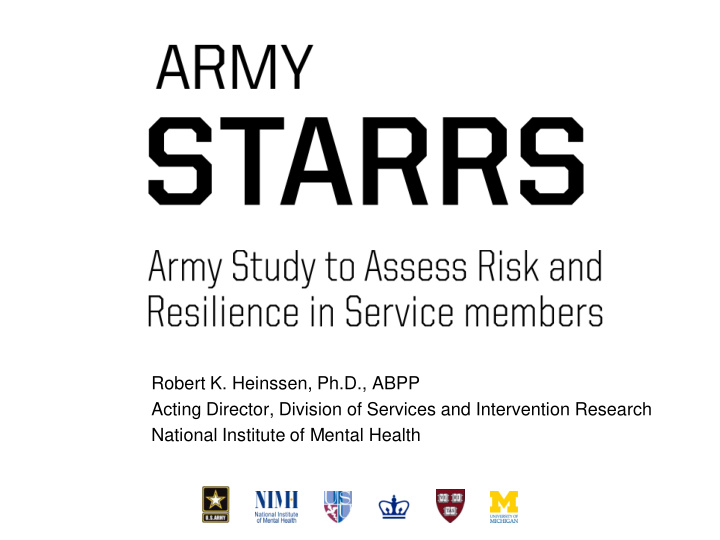



Robert K. Heinssen, Ph.D., ABPP Acting Director, Division of Services and Intervention Research National Institute of Mental Health
Suicide Deaths in U.S. Army 1990-2008 _____________________________________ 140 140 „08 Jelinek, P., Army suicide rates at record high . Associated Press , 5/30/2008 Army News Service, http://www.army.mil/-news/2009/03/31/19022-army-vice- chief-addresses-suicide-rate-across-army/, March 31, 2009
Purpose of Army STARRS _____________________________________ “The ultimate goal of this study is to develop data-driven methods for mitigating or preventing suicide behaviors and improving the overall mental health and behavioral functioning of Army Personnel during and after their Army service.” • Identify salient risk and protective factors – Genetic, neurobiological, cognitive features; social support, training experiences, cumulative stressors, triggering events • Inform development of empirically-derived interventions – Target malleable risk/protective factors in intervention and prevention trials conducted in real world settings • Deliver “actionable” findings rapidly – Interim data analyses, adaptive research design, iterative approach to signal detection and confirmation http://grants.nih.gov/grants/guide/rfa-files/RFA-MH-09-140.html
Impact of Risk and Protective Factor Research on Heart Disease Mortality _____________________________________ • 63% decrease in mortality 500 • ~ 1 million premature deaths/year averted Deaths per 100,000 ~ 1,329,000 400 Projected • $2.6 trillion in economic Deaths in 2000 300 return 200 • New, effective treatments and prevention strategies ~ 514,000 Actual 100 Deaths in 2000 1950 1960 1970 1980 1990 2000 Year
Translational Epidemiology Research _____________________________________ New New Signal Trial Sample(s) Wave(s) Hypotheses Signal Baseline Cross- Policies Section Trial & Hypotheses • Demographics Practice • Risk & Protective Factors New Trial Signal Hypotheses Wave(s) NIMH Division of Services and Intervention Research, 8/14/2008
Army STARRS Overview _____________________________________ • Cooperative Agreement Research Project (U01) • $50 million Total Costs for 5-year project period • Equal emphasis on risk and resilience factors related to suicidality and mental disorders, and behavioral health • Integration and coordination of efforts with relevant U.S. Army research and public health surveillance agencies (Army STARRS)
Army STARRS Investigators _____________________________________ Robert Ursano, M.D., Principal Investigator • Uniformed Services University of the Health Sciences Ronald Kessler, Ph.D. • Harvard University John Mann, M.D. • Columbia University Steven Heeringa, Ph.D. • University of Michigan, Ann Arbor U.S. Army and NIMH Scientists • U.S. Army Public Health Command (Provisional) • NIMH Division of Services and Intervention Research
Consortium Expertise _____________________________________ Uniformed Services University of the Health Sciences Clinical and Military Risk Factor epidemiology University of Michigan Columbia University Survey methodology, fieldwork and database Clinical/Neurobiological generation aspects of suicide Harvard University Psychiatric epidemiology Designing and executing large population-based studies
Scientific Activities _____________________________________ • Historical analysis of Soldiers with and without suicidal behavior since 2004 (using all data available on Active Duty Soldiers, 2004-2009) • Representative sample of 90,000 Active Duty Soldiers, including mobilized Reserve and National Guard Soldiers, will be surveyed • Census of new recruits in 2010, 2011, & 2012 (~80,000 – 120,000 Soldiers per year) • Longitudinal follow-up of 15,000 Soldiers selected on the basis of particular risk/profile characteristics
Special Features _____________________________________ • Feedback loop between retrospective data analysis, case control studies, and prospective surveys • Family-member and unit leadership informants to provide additional information about social and environmental context (culture/cohesion/stress) • Evaluation of current and future Army suicide prevention and treatment interventions • Exploration of potential neurobiological risk and protective factors
Timeline and Deliverables _____________________________________ _____________ 9 Dec 09 9 Dec 11
www.NIMH.NIH.GOV/ArmySTARRS
_____________________________________ Questions? For further information: Robert Heinssen, Ph.D, ABPP rheinsse@mail.nih.gov or ArmySTARRS@mail.nih.gov
Recommend
More recommend